Depiction of Jesus
| Part of a series on |
 |
The depiction of Jesus in pictorial form dates back to early Christian art and architecture, as aniconism in Christianity was rejected within the ante-Nicene period.[1][2][3][4] It took several centuries to reach a conventional standardized form for his physical appearance, which has subsequently remained largely stable since that time. Most images of Jesus have in common a number of traits which are now almost universally associated with Jesus, although variants are seen.
The conventional image of a fully bearded Jesus with long hair emerged around AD 300, but did not become established until the 6th century in
Images of Jesus tend to show ethnic characteristics similar to those of the culture in which the image has been created. Beliefs that certain images are historically authentic, or have acquired an authoritative status from Church tradition, remain powerful among some of the faithful, in Eastern Orthodoxy, Lutheranism, Anglicanism, and Roman Catholicism. The Shroud of Turin is now the best-known example, though the Image of Edessa and the Veil of Veronica were better known in medieval times.[not verified in body]
The representation of Jesus was controversial in the early period; the regional
Early Christianity
Before Constantine

Except for Jesus wearing
In the first-century AD, many Jews understood Exodus 20:4–6 ("
During the
The earliest surviving Christian art comes from the late 2nd to early 4th centuries on the walls of tombs belonging, most likely, to wealthy
Initially Jesus was represented indirectly by
Among the earliest depictions clearly intended to directly represent Jesus himself are many showing him as a baby, usually held by his mother, especially in the Adoration of the Magi, seen as the first theophany, or display of the incarnate Christ to the world at large.[22] The oldest known portrait of Jesus, found in Syria and dated to about 235, shows him as a beardless young man of authoritative and dignified bearing. He is depicted with close-cropped hair and wearing a tunic and pallium—the common male dress for much of Greco-Roman society, and similar to that found in the figure art in the Dura-Europos Synagogue.[23]
The appearance of Jesus had some theological implications. While some Christians thought Jesus should have the beautiful appearance of a young classical hero,

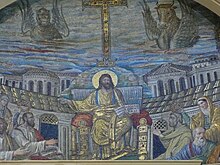
From the 3rd century onwards, the first narrative scenes from the 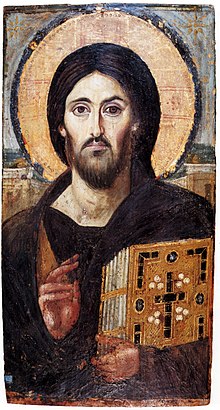
Jesus is sometimes shown performing miracles by means of a wand,
Another depiction, seen from the late 3rd century or early 4th century onwards, showed Jesus with a beard, and within a few decades can be very close to the conventional type that later emerged.
After the very earliest examples of c. 300, this depiction is mostly used for hieratic images of Jesus, and scenes from his life are more likely to use a beardless, youthful type.
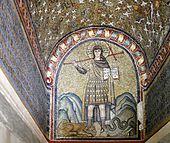
After Constantine
From the middle of the 4th century, after Christianity was legalized by the
Another depiction drew from classical images of philosophers, often shown as a youthful "intellectual
The Good Shepherd, now clearly identified as Christ, with halo and often rich robes, is still depicted, as on the
Once the bearded, long-haired Jesus became the conventional representation of Jesus, his facial features slowly began to be standardised, although this process took until at least the 6th century in the
French scholar Paul Vignon has listed fifteen similarities, or "marks," between most of the icons of Jesus after this point, particularly in the icons of "Christ Pantocrator" ("The all-powerful Messiah").
As to the historical appearance of Jesus, in one possible translation of the apostle Paul's
Later periods
Partly to aid recognition of the scenes, narrative depictions of the
The period of
The 13th century witnessed a turning point in the portrayal of the powerful
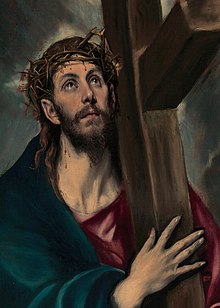
After
The High Renaissance was contemporary with the start of the
During the 17th century, some writers, such as
By the end of the 19th century, new reports of miraculous images of Jesus had appeared and continue to receive significant attention, e.g. Secondo Pia's 1898 photograph of the Shroud of Turin, one of the most controversial artifacts in history, which during its May 2010 exposition it was visited by over 2 million people.[70][71][72] Another 20th-century depiction of Jesus, namely the Divine Mercy image based on Faustina Kowalska's reported vision has over 100 million followers.[73][74] The first cinematic portrayal of Jesus was in the 1897 film La Passion du Christ produced in Paris, which lasted 5 minutes.[75][76] Thereafter cinematic portrayals have continued to show Jesus with a beard in the standard western depiction that resembles traditional images.[77]
A scene from the documentary film Super Size Me showed American children being unable to identify a common depiction of Jesus, despite recognizing other figures like George Washington and Ronald McDonald.[78]
Conventional depictions
Conventional depictions of Christ developed in medieval art include the narrative scenes of the Life of Christ, and many other conventional depictions:
Common narrative scenes from the Life of Christ in art include:
- Nativity of Jesus in art
- Adoration of the Shepherds
- Adoration of the Magi
- Finding in the Temple
- Baptism of Jesus
- Crucifixion of Jesus
- Descent from the Cross
- Last Judgement
Devotional images include:
- Madonna and child
- Christ in Majesty
- Christ Pantokrator
- Sacred Heart
- Pietà (mother and dead son)
- Lamb of God
- Man of sorrows
- Pensive Christ
Range of depictions
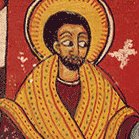
Certain local traditions have maintained different depictions, sometimes reflecting local racial characteristics, as do the Catholic and Orthodox depictions. The
In modern times such variation has become more common, but images following the traditional depiction in both physical appearance and clothing are still dominant, perhaps surprisingly so. In Europe, local ethnic tendencies in depictions of Jesus can be seen, for example in Spanish, German, or
Some medieval Western depictions, usually of the
In 2001, the television series Son of God used one of three first-century Jewish skulls from a leading department of forensic science in Israel to depict Jesus in a new way.[80] A face was constructed using forensic anthropology by Richard Neave, a retired medical artist from the Unit of Art in Medicine at the University of Manchester.[81] The face that Neave constructed suggested that Jesus would have had a broad face and large nose, and differed significantly from the traditional depictions of Jesus in renaissance art.[82] Additional information about Jesus' skin color and hair was provided by Mark Goodacre, a New Testament scholar and professor at Duke University.[82]
Using third-century images from a synagogue—the earliest pictures of Jewish people[83]—Goodacre proposed that Jesus' skin color would have been darker and swarthier than his traditional Western image. He also suggested that he would have had short, curly hair and a short cropped beard.[84] Although entirely speculative as the face of Jesus,[81] the result of the study determined that Jesus' skin would have been more olive-colored than white or black,[82] and that he would have looked like a typical Galilean Semite. Among the points made was that the Bible records that Jesus's disciple Judas had to point him out to those arresting him in Gethsemane. The implied argument is that if Jesus's physical appearance had differed markedly from his disciples, then he would have been relatively easy to identify.[84]
Miraculous images of Jesus
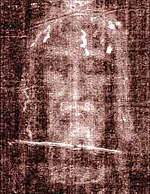
There are, however, some images which have been claimed to realistically show how Jesus looked. One early tradition, recorded by
A currently familiar depiction is that on the
Before 1898, devotion to the
A very popular 20th-century depiction among Roman Catholics and Anglicans is the
Faustina wrote in her diary that Jesus appeared to her and asked her to "Paint an image according to the pattern you see".
With episcopal approval from Bishop Tadros of Port Said and Bishop Yuhanna of Cairo, "Sallman's Head of Christ was exhibited in the Coptic Church", with "more than fifty thousand people" visiting the church to see it.[96] In addition, several religious magazines have explained the "power of Sallman's picture" by documenting occurrences such as headhunters letting go of a businessman and fleeing after seeing the image, a "thief who aborted his misdeed when he saw the Head of Christ on a living room wall", and deathbed conversions of non-believers to Christianity.[97] As an extraordinarily successful work of Christian popular devotional art,[98] it had been reproduced over half a billion times worldwide by the end of the 20th century.[99]
Examples
-
A representation of Jesus as Sol Invictus. Mosaic of the 3rd century on the Tomb of the Julii under St. Peter's Basilica.
-
Christ holding Gospel of John, miniature in Syriac manuscript DIYR 339, a 6th-century gospel book from St. Mary Church, Diyarbakır
-
Jesus depicted on an early 8th-century Byzantine coin. After theByzantine iconoclasmall coins had Christ on them.
-
Restored Church of the East painting of Jesus Christ, 9th century
-
A beardless Christ in the Anglo-Saxon New Minster Charter, Winchester, mid-10th century
-
Reconstruction of the enthroned Jesus (Yišō) image on a Manichaean temple banner from c. 10th-century Qocho (East Central Asia)
-
11th-century Christ Pantocrator with the halo in a cross form, used throughout the Middle Ages. Characteristically, he is portrayed as similar in features and skin tone to the culture of the artist.
-
"Christ All Mercy" Eastern Orthodox icon
-
Manichaean Painting of the Buddha Jesus, a 12th- or 13th-century Chinese hanging scroll depicting Jesus Christ as the Manichaean prophet Yišō
-
Jesus ChristPantocrator – 13th-century mosaic from Hagia Sophia
-
An unusual 15th-century image of Jesus as a medieval knight bearing an attributed coat of arms based on the Veil of Veronica
-
The Baptism of Jesus Christ, by Piero della Francesca, c. 1448-1450
-
Portrait of Jesus by Cima da Conegliano (1459–1517)
-
Christ as the Suffering Redeemeer, c. 1488–1500, by Andrea Mantegna
-
A Nestorian "Crucifixion of Jesus", illustration from the Nestorian Evangelion, 16th century
-
Palma il Vecchio, Head of Christ, 16th century, Italy
-
Mary and Christ, in The Last Judgement by Michelangelo (1541). This depiction was much criticised.
-
The Crucifixion of Christ, 1558, by Titian
-
Carracci, 1594
-
Jesus, aged 12, Jesus among the Doctors (as a child debating in the temple), 1630 by Jusepe de Ribera
-
Holy Spiritdescending as a dove, 1723
-
19th-century Russian icon of Christ Pantocrator
-
A traditional Ethiopian depiction of Jesus and Mary with distinctively Ethiopian features
-
Head of Jesus (1890) by Enrique Simonet
-
Christ Pantocrator mosaic in the dome above the Katholikon of the Church of the Holy Sepulchre in Jerusalem
-
Crucifixion of Jesus as depicted in the Ethiopian Alwan Codex, 20th century
-
Jesus Christ as painted in the Church of Hässleholm, Sweden, by the painter Georg Hansen (1868-1932)
-
Jesus asSt John's Ashfield
-
A mural (1951) depicting the baptism of Jesus in a typical Haitian rural scenery, Cathédrale de Sainte Trinité, Port-au-Prince, Haiti
-
The Word of Life (1964) mural on the side of the Hesburgh Library at the University of Notre Dame
-
Depiction of Jesus at the Santuario de San Jose in Mandaluyong, Philippines
-
Artist's impression of the face on the shroud of Turin which perhaps records the image of the historical Jesus of Nazareth
Sculpture
-
Monumento al Divino Salvador del Mundo is an iconic landmark that represents San Salvador city. It symbolizes the Transfiguration of Jesus standing on top of Earth as the savior of the world
-
Michelangelo's Pietà, 1498–99, shows Mary holding the dead body of Jesus
-
Cristo de la Concordia in Bolivia, claimed to be the largest statue of Jesus ever made
-
Cristo del Otero, above Palencia, Spain
-
Church of Our Lady, Copenhagen
-
Infant Jesus of Prague, one of several miniature statues of an infant Christ that are much venerated by the faithful
-
The Cristo Negro, at the Iglesia de San Felipe, Portobelo, Panama.
-
16th century sculpture of suffering Christ, Cheb, Czechia.
See also
- Category:Cultural depictions of Jesus
- Crucifixion
- God the Father in Western art
- Holy card
- Ichthys
- List of statues of Jesus
- Perceptions of religious imagery in natural phenomena
- Race and appearance of Jesus
- Resurrection of Jesus in Christian art
- Salvator Mundi
- Veil of Veronica
- Passion Play
- Christ figure
Notes
- ^ Philip Schaff commenting on Irenaeus, wrote, 'This censure of images as a Gnostic peculiarity, and as a heathenish corruption, should be noted'. Footnote 300 on Contr. Her. .I.XXV.6. ANF
- ^ Synod of Elvira, 'Pictures are not to be placed in churches, so that they do not become objects of worship and adoration', AD 306, Canon 36
- ^ Kitzinger, Ernst, "The Cult of Images in the Age before Iconoclasm", Dumbarton Oaks Papers, Vol. 8, (1954), pp. 83–150, Dumbarton Oaks, Trustees for Harvard University, JSTOR
- ISSN 0043-4388. Retrieved 2 March 2022.
- ^ Lisa Maurice, Screening Divinity, Edinburgh University Press, Scotland, 2019, p. 30
- ^ Robin M. Jensen, The Cross: History, Art, and Controversy, Harvard University Press, USA, 2017, p. 185
- ^ Cameron J. Anderson, The Faithful Artist: A Vision for Evangelicalism and the Arts, InterVarsity Press, USA, 2016, p. 124
- ^ Doug Jones, Sound of Worship, Taylor & Francis, Abingdon-on-Thames, 2013, p. 90
- ^ Matthew 14:46
- ^ Luke 8:43–44
- ISBN 978-0-567-67150-9.
- ^ Harold W. Attridge, Gohei Hata, et al. Eusebius, Christianity, and Judaism. Wayne, MI: Wayne State University Press, 1992. pp. 283–284.
- ISBN 978-1-4725-2365-5.
- ^ English translation found at Catholic University of America, accessed 5 September 2012 [1]
- ^ John Calvin Institutes of the Christian Religion Book 1, Chapter V. Section 6.
- ^ Hellemo, pp. 3–6, and Cartlidge and Elliott, 61 (Eusebius quotation) and passim. Clement approved the use of symbolic pictograms.
- ^ The Second Church: Popular Christianity A.D. 200–400 by Ramsay MacMullen, The Society of Biblical Literature, 2009
- ISBN 978-0-312-66691-0. Retrieved 5 August 2013.
- ^ Orpheus as a symbol for David was already found in hellenized Jewish art. Hall, 66
- ^ Syndicus, 21–3
- ^ Cartlidge and Elliott, 53–55. See also The Two Faces of Jesus by Robin M. Jensen, Bible Review, 17.8, October 2002, and Understanding Early Christian Art by Robin M. Jensen, Routledge, 2000
- ^ Hall, 70–71
- ISBN 978-1-350-92807-7.
- ^ Zanker, 299
- ISBN 0-600-34290-5
- ^ Syndicus, 92
- ^ Cartlidge and Elliott, 53 – this is Psalm 44 in the Latin Vulgate; English bible translations prefer "glory" and "majesty"
- ^ Zanker, 302.
- Lucina in the Catacombs_of_San_Callisto. There are a number of other 3rd-century images.
- ^ Painted over 40 times in the catacombs of Rome, from the early 3rd century on, and also on sarcophagii. As with the Baptism, some early examples are from Gaul. Schiller, I, 181
- ^ Syndicus, 94–95
- ^ Syndicus, 92–93, Catacomb images
- ^ "Catholic Encyclopedia: Portraits of the Apostles". Retrieved 10 August 2008.
- ^ Cartlidge and Elliott, 60
- ^ The Two Faces of Jesus by Robin M. Jensen, Bible Review, 17.8, Oct 2002
- ^ a b New Catholic Encyclopedia: Portraits of the Apostles
- ^ Jesus, the Magician by Morton Smith, Harper & Row, 1978
- ^ Jefferson, Lee M. (2020). "Jesus the Magician? Why Jesus holds a wand in early Christian art". Biblical Archaeology Society Library. Retrieved 25 February 2024.
- ^ Zanker, 302
- ^ Zanker, 300–303, who is rather dismissive of other origins for the type
- ^ Syndicus, 93
- ^ Cartlidge and Elliott, 56–57. St Paul often has a long beard, but short hair, as in the catacomb fresco illustrated. St John the Baptist also often has long hair and a beard, and often retains in later art the thick shaggy or wavy long hair seen on some of the earliest depictions of Jesus, and in images of philosophers of the Charismatic type.
- ^ Zanker, 257–266 on the charismatics; 299–306 on the type used for Christ
- ^ Zanker, pp. 299, note 48, and 300. [2]. See also Cartlidge and Elliott, 55–61.
- ^ Grabar, 119
- ^ Zanker, 290
- ^ Syndicus, 92–97, though images of Christ the King are found in the previous century also – Hellemo, 6
- ^ Hellemo, 7–14, citing K. Berger in particular.
- ^ Zanker, 299. Zanker has a full account of the development of the image of Christ at pp. 289–307.
- ^ The two parts of the cycle are on opposite walls of the nave; Talbot Rice, 157. Bridgeman Library Archived 11 March 2012 at the Wayback Machine
- ISBN 0198810504
- ISBN 1-885395-96-5)
- ^ The Shroud of Christ ("Constantinople") by Paul Vignon, Paul Tice, op. cit.
- ^ Grigg, 5–7
- ^ Regarding the alternate NIV translation of 1 Corinthians 11:7, and in agreement with modern interpretations of the New Testament, Walvoord and Zuck note, "The alternate translation in the NIV margin, which interprets the man's covering as long hair, is largely based on the view that verse 15 equated the covering with long hair. It is unlikely, however, that this was the point of verse 4." John F. Walvoord and Roy B. Zuck, eds., The Bible Knowledge Commentary: New Testament, "1 Corinthians 11:4", (Wheaton: Victor Books, 1983)
- ISBN 0-8308-2492-8. Google Books
- ^ ISBN 0-8264-8011-Xpp. 51–53
- ISBN 978-1-4443-5175-0.
- ^ ISBN 0-85331-270-2pp. 181–184
- ISBN 1-879038-15-3pp. 226–227
- ISBN 978-0-88141-026-6pp. 81–90
- ^ ISBN 0-521-78291-0pp. 183–184
- ISBN 0-8146-3184-3pp. 86–87
- ^ ISBN 0-8369-2378-2pp. 110–112
- ISBN 0-7425-5157-1pp. 3–5
- ISBN 0-7614-1475-4p. 109
- ISBN 978-0-534-64114-6pp. 382–383
- ^ Leonardo da Vinci, the Last Supper: a Cosmic Drama and an Act of Redemption by Michael Ladwein 2006 pp. 27, 60
- ^ Browne, Thomas. The Works of Thomas Browne Vol. 2. Gutenberg.
- ISBN 0-7661-3425-3pp. 2–9
- ^ William Meacham, The Authentication of the Turin Shroud:An Issue in Archaeological Epistemology, Current Anthropology, Volume 24, No 3, June 1983
- ^ "Zenit, May 5, 2010". Zenit.org. 5 May 2010. Archived from the original on 27 September 2012. Retrieved 4 November 2011.
- ISBN 978-0-87973-923-2p. 165
- ^ ISBN 978-1-58617-257-2p. 548
- ISBN 90-04-16861-3p. 1
- ISBN 0-415-23440-9p. 518
- ISBN 1-4051-9362-Xp. 526
- ^ ""Super Size Me": Recognizing Jesus". Archived from the original on 5 July 2022. Retrieved 13 August 2020.
- ^ A 12th-century English example is in the Getty Museum Archived 7 June 2010 at the Wayback Machine
- OCLC 60623878. Retrieved 12 May 2011.
- ^ a b Legon, Jeordan (25 December 2002). "From science and computers, a new face of Jesus". CNN. Retrieved 12 May 2011.
- ^ a b c Wilson, Giles (27 October 2004). "So what color was Jesus?". BBC News. London. Retrieved 12 May 2011.
- ^ "Experts Reconstruct Face Of Jesus". London: CBS. 27 March 2001. Retrieved 12 May 2011.
- ^ OCLC 3643271. Retrieved 12 May 2011.
- ^ William Meacham, The Authentication of the Turin Shroud: An Issue in Archaeological Epistemology, Current Anthropology, Volume 24, No 3, June 1983
- ^ The Rev. Albert R. Dreisbach (1997). "The Shroud of Turin: Its Ecumenical Implications".
Returning to the ecumenical dimension of this sacred linen, it became very evident to me on the night of August 16, 1983, when local judicatory leaders offered their corporate blessing to the TURIN SHROUD EXHIBIT and participated in the Evening Office of the Holy Shroud. The Greek Archbishop, the Roman Catholic Archbishop, the Episcopal Bishop and the Presiding Bishop of the AME Church gathered before the world's first full size, backlit transparency of the Shroud and joined clergy representing the Assemblies of God, Baptists, Lutherans, Methodists and Presbyterians in an amazing witness to ecumenical unity. At the conclusion of the service, His Grace Bishop John of the Greek Orthodox Diocese of Atlanta, turned to me and said: "Thank you very much for picking our day." I didn't fully understand the significance of his remark until he explained to me that August 16th is the Feast of the Holy Mandylion commemorating the occasion in 944 A.D. when the Shroud was first shown to the public in Byzantium following its arrival the previous day from Edessa in southeastern Turkey.
{{cite web}}: Missing or empty|url=(help) - ISBN 0-87973-701-8p. 49
- ^ ISBN 0-87973-910-Xpp. 239, 635
- ISBN 978-1-59884-654-6.
- ^ ISBN 978-1-4033-1009-5pp. 85–95
- ^ ISBN 1-4502-3236-1"The Image of Divine Mercy" pp. 84–107
- ISBN 978-0-87973-923-2pp. 63–64
- ISBN 978-0-86012-383-5p. 252
- ISBN 978-0-300-06342-4.
Sallman always insisted that his initial sketch of Jesus was the result of spiritual "picturization," a miraculous vision that he received late one night. "The answer came at 2 A.M., January 1924," he wrote. "It came as a vision in response to my prayer to God in a despairing situation." The situation was a deadline: Sallman had been commissioned to paint the February cover for the Covenant Companion, the monthly magazine of the Evangelical Covenant Church, and he had artist's block for weeks. The February issue was focusing on Christian youth, and Sallman's assignment was to provide an inspirational image of Christ that would "challenge our young people." "I mused over it for a long time in prayer and meditation," Sallman recalled, "seeking for something which would catch the eye and convey the message of the Christian gospel on the cover."
- ISSN 0273-3269.
An interesting case of inculturation occurred on Monday, November 11, 1991 when the 12-year-old Isaac Ayoub of Houston, Texas, suffering from leukemia, saw that the eyes of Jesus in the famous Sallman Head of Christ began moving and shedding an oily liquid like tears. On the same day, Fr. Ishaq Soliman, the Coptic priest of St. Mark's Coptic Church in Houston, testified to the miracles. On the following day, Dr. Atef Rizkalla, the family physician, examined the youth and certified that there were no traces of leukemia. Sallman's Head of Christ was exhibited in the Coptic Church and more than 50,000 people visited the church. Two Coptic bishops, Anbâ Tadros of Port Said and Anbâ Yuhanna of Cairo verified the story.
- ^ ISBN 978-1-61797-262-1.
An interesting case of inculturation took place on Monday, November 11, 1991 when the twelve-year-old Isaac Ayoub of Houston, Texas, suffering from leukemia, saw that the eyes of Jesus in the famous Sallman "Head of Christ" began moving and shedding an oily liquid like tears. On the same day, Father Ishaq Soliman, the Coptic priest of St. Mark's Coptic Church in Houston, testified to the miracles. On the following day, Dr. Atef Rizkalla, the family physician, examined the youth and certified that there were no traces of leukemia. Sallman's Head of Christ was exhibited in the Coptic Church and more than fifty thousand people visited the church. Two Coptic bishops, Bishop Tadros of Port Said and Bishop Yuhanna of Cairo, verified the story.
- ISBN 978-0-300-06342-4.
Articles published in popular religious magazines during this time gathered together in an obviously didactic way several anecdotes concerning the power of Sallman's picture among nonwhites, non-Christians, and those exhibiting unacceptable behavior. We read of a white businessman, for instance, in a remote jungle, assaulted by a vicious group of headhunters who demand that he remove his clothes. In going through his billfold, they discover a small reproduction of Sallman's Christ, quickly apologize, then vanish "into the jungle without inflicting further harm." A second article relates the story of the thief who aborted his misdeed when he saw the Head of Christ on a living room wall. Another tells of the conversion of a Jewish woman on her deathbed, when a hospital chaplain shows her Sallman's picture.
- ISBN 978-0-313-27895-2. Retrieved 30 April 2014.
Of these one stands out as having deeply impressed itself of the American religious consciousness: the Head of Christ by artist Warner Sallman (1892–1968). Originally sketched in charcoal as a cover illustration for the Covenant Companion, the magazine of the Swedish Evangelical Mission Covenant of America denomination, and based on an image of Jesus in a painting by the French artist Leon Augustin Lhermitte, Sallman's Head of Christ was painted in 1940. In half a century, it had been produced more than five hundred million times in formats ranging from large-scale copies for use in churches to wallet-sized ones that individuals could carry with them at all times.
- ISBN 978-0-8078-3737-5. Retrieved 30 April 2014.
By the 1990s, Sallman's Head of Christ had been printed more than 500 million times and had achieved global iconic status.
- ^ "Construction progressing on new Jesus statue along I-75". WCPO. 15 June 2012. Archived from the original on 29 June 2013. Retrieved 7 September 2012.
References
- Cartlidge, David R., and Elliott, J.K.. Art and the Christian Apocrypha, Routledge, 2001,
- Every, George; Christian Mythology, Hamlyn 1988 (1970 1st edn.) ISBN 0-600-34290-5
- Grabar, André; Christian iconography: a study of its origins, Taylor & Francis, 1968,
- Grigg, Robert, "Byzantine Credulity as an Impediment to Antiquarianism", Gesta, Vol. 26, No. 1 (1987), pp. 3–9, The University of Chicago Press on behalf of the International Center of Medieval Art, JSTOR
- James Hall, A History of Ideas and Images in Italian Art, 1983, John Murray, London, ISBN 0-7195-3971-4
- Hellemo, Geir. Adventus Domini: eschatological thought in 4th-century apses and catecheses. Brill; 1989. ISBN 978-90-04-08836-8.
- G Schiller, Iconography of Christian Art, Vol. I, 1971 (English trans from German), Lund Humphries, London, ISBN 0-85331-270-2
- Eduard Syndicus; Early Christian Art; Burns & Oates, London, 1962
- David Talbot Rice, Byzantine Art, 3rd edn 1968, Penguin Books Ltd
- Zanker, Paul. de:Paul Zanker. The Mask of Socrates, The Image of the Intellectual in Antiquity, University of California Press, 1995 Online Scholarship editions

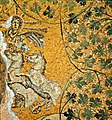









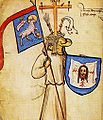





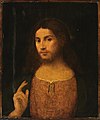











![Jesus Christ as painted in the Church [sv] of Hässleholm, Sweden, by the painter Georg Hansen (1868-1932)](http://upload.wikimedia.org/wikipedia/commons/thumb/8/8a/Jesus_by_Georg_Hansen.jpg/98px-Jesus_by_Georg_Hansen.jpg)









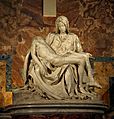




![Lux Mundi, a statue of Jesus by Tom Tsuchiya completed in 2012[100]](http://upload.wikimedia.org/wikipedia/commons/thumb/0/05/Lux_Mundi%2C_the_sculpture_of_Jesus_at_Solid_Rock_Church.jpg/120px-Lux_Mundi%2C_the_sculpture_of_Jesus_at_Solid_Rock_Church.jpg)


![16th century sculpture of suffering Christ [cs], Cheb, Czechia.](http://upload.wikimedia.org/wikipedia/commons/thumb/5/5f/Bolestn%C3%BD_Kristus_%28po%C4%8D._16._stol.%29%2C_Cheb.jpg/80px-Bolestn%C3%BD_Kristus_%28po%C4%8D._16._stol.%29%2C_Cheb.jpg)